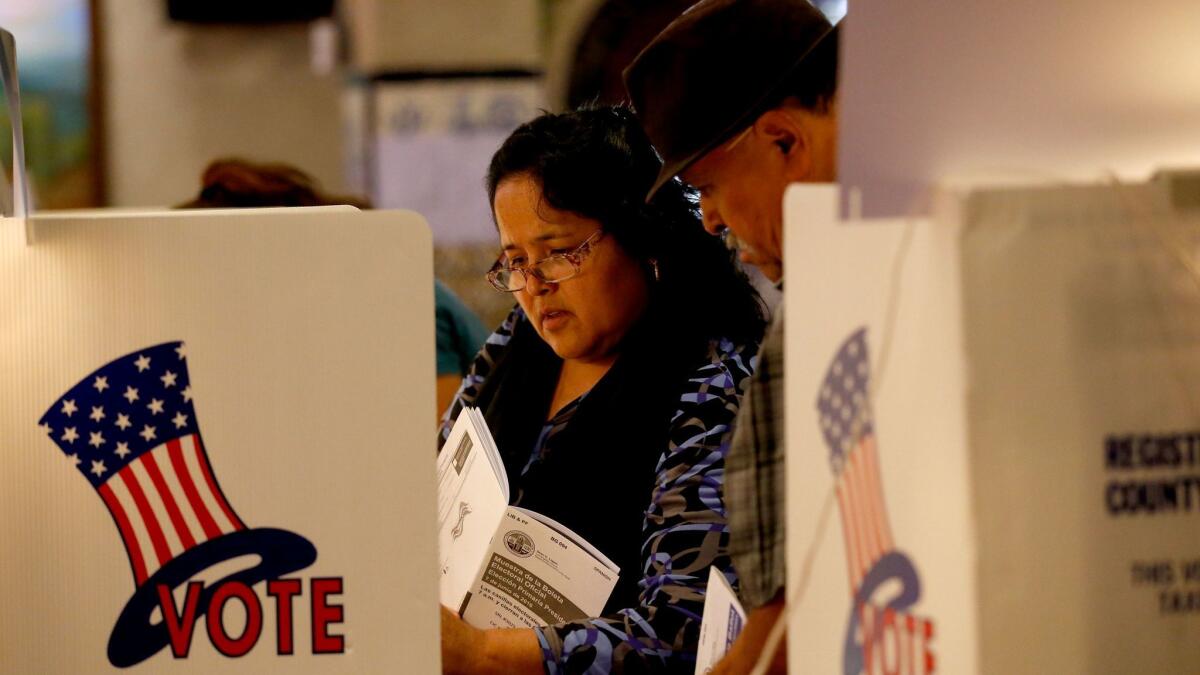Column: This is the group of California voters everyone will be watching in 2018

Reporting from Sacramento — Politics is full of references likening one group or another to a “sleeping giant,” a powerful voting bloc that could change the outcome in any given election.
In California, it’s almost always used to describe Latino voters. While now the state’s single largest ethnicity, Latinos often are underrepresented on election day with lackluster turnout that continues to be one of the state’s most perplexing political dynamics.
“For too long and too many cycles, Latinos have not participated at the levels that they should,” said Michael Bustamante, a public affairs executive and one-time advisor to former Gov. Gray Davis, a Democrat.
Bustamante is one of the architects of Civica Latino, a nonprofit organization with ambitious goals to boost Latino turnout by as many as 700,000 voters in the June 5 statewide primary election next year. And it may very well have to happen one voter at a time.
“That person-to-person engagement is where the dramatic investment needs to take place,” said Mike Madrid, a longtime Republican strategist and one of the new organization’s leaders.
In an admittedly low turnout year for just about every subgroup of California voters, Latinos were hugely underrepresented in the 2014 primary, accounting for only 12% of the votes cast despite representing 23% of registered voters. That general trend has held true for years. And with the state’s shift to the top-two primary, the dilution of Latino voices can be especially noticeable: They aren’t voting in the one election with a wide array of candidates, before the choices have been pared down to just two people on the ballot in November.
And here’s the dirty little secret about campaigns: The less you vote, the less the political world sees you as a “likely voter” that’s worth a candidate’s time, which means the less they reach out to you in the future. In which case, voters may become even less informed, and less enthused to cast a ballot on a regular basis — and the vicious cycle gets even worse.
Political Road Map: This is why it always seems to take so long to count ballots in California »
“We’re trying to do an intervention that’s not candidate-based or party-based,” said John A. Pérez, the former Assembly speaker who also is a leader of Civica Latino.
That kind of nonpartisan approach is notable, as most voter engagement efforts are conducted for a particular party or candidate — and not broadly to a large group of voters statewide. Of course, any campaign to boost Latino turnout is likely to help Democrats the most; there are three times as many Latino Democrats in the state as Republicans in California.
Boosting Latino voter participation also could rewrite another long-standing political axiom in California: the dominance of the Bay Area over Southern California. Simply put, Bay Area voters turn out at much higher rates than those in Los Angeles and surrounding communities. Latino voters are more highly concentrated in southern counties, and getting more of them to cast ballots could add some muscle in statewide races that have become largely dominated by Northern California politicians.
So where does the money come for the nonprofit hoping to get more Latino voters to show up? The backers of the new group are counting on foundations as well as business and labor groups, making the point that everyone is helped when a key part of the California mosaic has its voice heard at the polls. Without those voters showing up, Pérez said, “our democracy pays the price.”
Follow @johnmyers on Twitter, sign up for our daily Essential Politics newsletter and listen to the weekly California Politics Podcast
ALSO:
Political Road Map: It’s hard for Republicans to win statewide in California without candidates
More Californians will vote by mail, fewer at polling places starting in 2018
Updates on California politics and government
More to Read
Get the L.A. Times Politics newsletter
Deeply reported insights into legislation, politics and policy from Sacramento, Washington and beyond. In your inbox three times per week.
You may occasionally receive promotional content from the Los Angeles Times.











